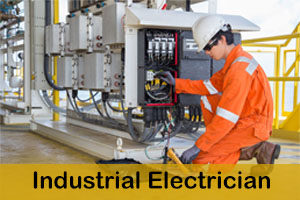Industrial Electrician
At Burrāq UK, we pride ourselves on delivering expert industrial electrical services tailored to meet the evolving needs of modern industries. As a trusted Industrial Electrician, I bring hands-on experience and technical expertise in installing, maintaining, and troubleshooting complex electrical systems in industrial environments, including manufacturing plants, warehouses, and processing facilities.

Aim of Industrial Electrician
The primary aim of an Industrial Electrician is to install, maintain, repair, and troubleshoot electrical systems and equipment in industrial settings to ensure continuous, safe, and efficient operation of machinery and infrastructure.
Course Overview
Industrial Electrician
Total Modules 10
Training Credits 120
Directed Learning Hours (DLH) 250
Course Code BUK1126
Educational Requirements:
- Minimum Age: Usually 16+ to begin apprenticeship or vocational training
- Basic Education GCSEs (or equivalent) – typically grades 9 to 4 (A to C)* in:
- Maths
- English
- Science or Technology (preferred)
- Vocational Training / Qualifications:
- Electrical Installation Qualification (One of the following):
- NVQ Level 3 in Electrical Installation (Building and Structures)
- City & Guilds 2365 Level 2 and 3 (Diploma in Electrical Installations)
- T-Level in Building Services Engineering (Electrical Installation Pathway)
- EAL Level 3 Diploma in Electrical Installation
- Apprenticeship Pathway (Recommended):
- Complete a 4-year Electrotechnical Apprenticeship
- Achieve an NVQ Level 3 plus an AM2 Assessment (final competence exam)
- Essential Certifications & Requirements:
- 18th Edition Wiring Regulations (BS 7671) – Required to work legally and safely
- ECS Gold Card (via JIB) – Proof of qualified Electrician status in the UK
- Health & Safety Training – e.g., CSCS or ECS Health & Safety test
AM2 Assessment – Practical test to assess competence (for NVQ holders)
| Course Code | Curriculum Title | Credit | DLH |
|---|---|---|---|
| 1126-1 | Introduction to Electrical Technology | 2 | 25 |
| 1126-2 | Health, Safety & PPE | 2 | 25 |
| 1126-3 | Electrical Tools & Equipment | 2 | 25 |
| 1126-4 | Motors & Motor Control Systems | 2 | 25 |
| 1126-5 | Electrical Drawings and Diagrams | 2 | 25 |
| 1126-6 | Industrial Lighting Systems | 2 | 25 |
| 1126-7 | Power Distribution & Earthing | 2 | 25 |
| 1126-8 | Preventive & Corrective Maintenance | 2 | 25 |
| 1126-9 | Testing, Commissioning & Regulations | 2 | 25 |
| 1126-10 | PLCs & Industrial Automation | 2 | 25 |
Module 1: Introduction to Electrical Technology
- Basics of electricity
- Current, voltage, resistance (Ohm’s Law)
- AC vs. DC
- Units and measurement tools
Module 2: Health, Safety & PPE
- Electrical safety standards (UK & International)
- Use of PPE (Personal Protective Equipment)
- Lockout/Tagout (LOTO) procedures
- Risk assessments
Module 3: Electrical Tools & Equipment
- Hand tools and power tools
- Testing instruments (multimeter, megger, clamp meter)
- Cable handling and storage
Module 4: Wiring Systems & Electrical Installation
- Types of cables and wires
- Wiring systems (conduit, trunking, armoured cables)
- Circuit types (ring, radial)
- Socket, switch, and lighting installations
Module 5: Motors & Motor Control Systems
- Types of motors (AC/DC, single-phase, three-phase)
- Motor starters (DOL, Star-Delta, VFD)
- Overload protection
Module 6: Electrical Drawings and Diagrams
- Reading and interpreting electrical blueprints
- Wiring schematics
- Control panel layout
Module 7: Fault Diagnosis & Troubleshooting
- Common industrial electrical faults
- Diagnostic procedures
- Use of testing equipment
Module 8: Industrial Lighting Systems
- Types of industrial lighting
- Emergency lighting
- Lighting design and layout
Module 9: Power Distribution & Earthing
- Main distribution boards
- Transformers and switchgear
- Earthing and bonding systems
Module 10: PLCs & Industrial Automation (Intro Level)
- What is a PLC?
- Basic PLC architecture
- Wiring input/output devices
- Basic ladder logic introduction
Module 11: Preventive & Corrective Maintenance
- Maintenance schedules
- Inspection and testing
- Maintenance reporting
Module 12: Testing, Commissioning & Regulations
- Continuity and insulation testing
- Final commissioning of installations
- Compliance with IET Wiring Regulations (BS 7671 – 18th Edition)
Module 13: Capstone Project / Practical Assessment
- Students complete a hands-on industrial wiring or panel-building project
- Oral or written presentation
- Final skill test (can include AM2-style evaluation)
- Matric (10th Grade) or equivalent
- DAE (Diploma of Associate Engineering) in Electrical, Electronics, or Mechanical
- City & Guilds Level 2 or 3, or equivalent vocational certifications
- Electricians, Technicians, or Industrial Helpers already working in factories or construction sites.
- All Modules within this qualification are assessed internally by the approved training Centre and externally verified by BURRAQ UK. The program uses a criterion-referenced assessment approach to ensure that learners successfully meet all required learning outcomes.
- A Pass in any unit is granted only when the learner submits valid, reliable, and authentic evidence that demonstrates achievement of the assessment criteria. The Assessor is responsible for reviewing this evidence and confirming that the learner has attained the expected standard.
- To guarantee fairness, transparency, and consistency, assessors are required to maintain a detailed audit record, clearly documenting the basis of their assessment decisions in line with quality assurance requirements.
